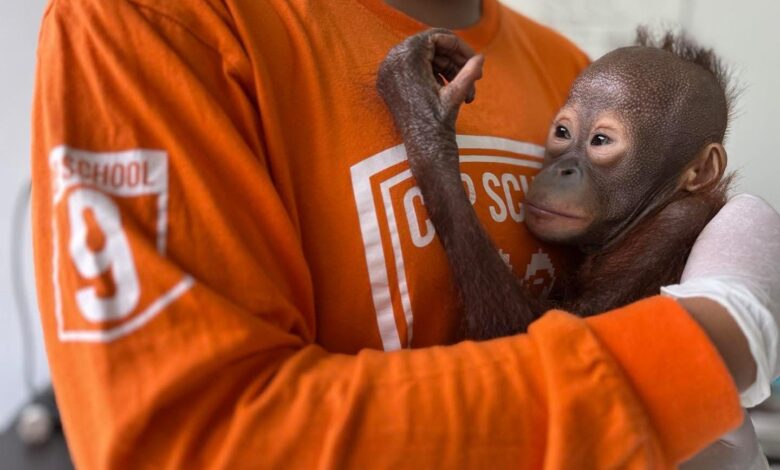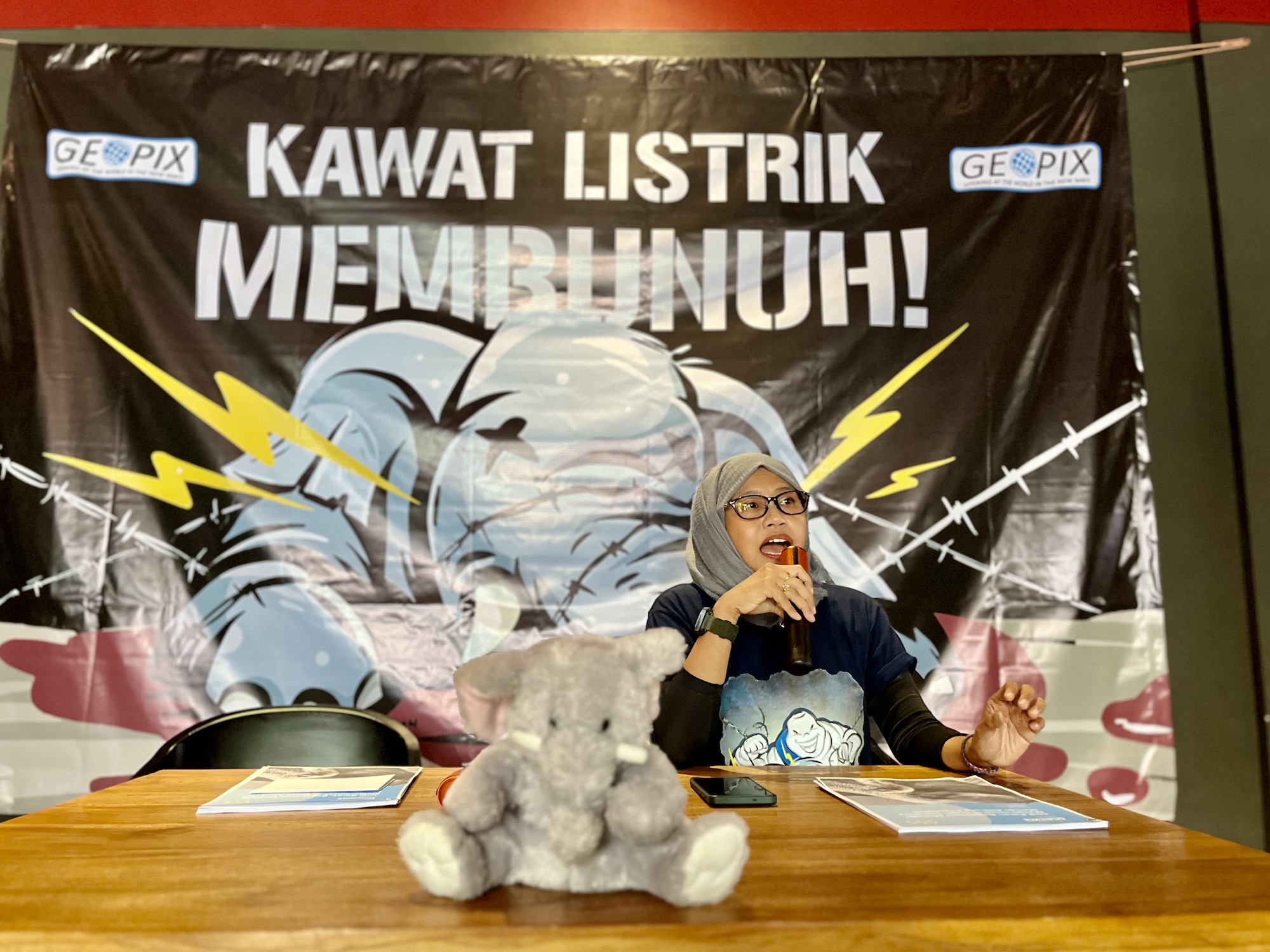Who’s Killing Off the Orangutans?

By Muhammad Andi Firmansyah
Nine years ago, in Sangkulirang, East Kutai, a team from the East Kalimantan Natural Resources Conservation Agency (BKSDA) found a baby Bornean orangutan. Its body was frail, its umbilical cord was still wet, it had not yet grown teeth, and it was gasping for breath. The baby was then named Popi. Since that day, Popi has lived at the Borneo Orangutan Rescue Alliance (BORA) rehabilitation center in Berau, fighting just to grow into herself. Her mother was never found. She was forced to live a miserable life, all alone.
Popi’s story is just a small portrait of a much larger tragedy befalling the orangutan.
Indonesia bears a very heavy responsibility to protect them. Of the approximately 71,800 orangutans on the planet, more than 60,000 live in the forests of the archipelago. Its three species (Pongo abelii and Pongo tapanuliensis in Sumatra, and Pongo pygmaeus in Borneo) are all classified as Critically Endangered. The Tapanuli orangutan (Pongo tapanuliensis), only identified as a separate species in 2017, is now left with fewer than 800 individuals.
Scientists agree that the primary cause of this population decline is habitat loss due to deforestation. Orangutans are highly dependent on intact forests, yet Indonesia lost nearly 9.5 million hectares of primary forest between 2002 and 2019, mostly in Sumatra and Kalimantan. In the last three years of that period alone (2016-2019), more than 739,000 hectares of orangutan habitat were lost.
Meanwhile, conservationists add poaching and the illegal wildlife trade to the list. This factor is, in fact, still connected to deforestation. As the forest shrinks, orangutans are pushed out of their habitat, forcing them into direct contact with humans. They damage gardens, are considered pests, and are then killed. Data shows that each year, approximately 2,200 Bornean orangutans are killed due to conflict or poaching.
These explanations are correct, but unfortunately, they still leave a gaping hole. They can explain how orangutans die, but they fail to sufficiently dig into why it all continues to happen, even after we know the dangers. It is as if this massive problem were just a series of ecological accidents that need to be patched up with rehabilitation and patrols. Meanwhile, the machine that keeps these causes in motion is left to run, unidentified.
Here, I wish to name that “machine” as “structural violence,” a term coined by Norwegian sociologist Johan Galtung.
Structural violence helps us see how harm can be produced by a system, without anyone needing to raise a weapon or pull a trigger. This type of violence infiltrates policies, markets, and even social norms, working slowly but surely to deprive victims of the life chances they should have had. And although this concept was originally designed to narrate human suffering, I am dismayed that its accuracy in explaining the erosion of orangutan existence is astonishing.
Just as people die of starvation, orangutans do not always die because someone is directly firing a bullet at them. There is no official decree ordering their extermination, just as there is no law that openly “legalizes” starvation. Yet, people can die because of a socio-economic structure that fails to provide food, or because of policies that make prices unaffordable.
In the case of orangutans, they are pushed to the brink by a series of decisions, policies, and market forces that cause them to lose their homes. The forest, their home, is licensed away. Every plot of land cleared, every concession granted to a company, and every road that splits the forest is the result of a signature on a legal document. In a sense, ironically, orangutans die because of decisions made in offices far from the forest.
Another hallmark of structural violence is its temporality. Direct violence occurs in a moment: a gunshot, an arrest, a clash. Structural violence, by contrast, is a process. It unfolds slowly, often imperceptibly, over years and decades.
The extinction of the orangutan is this kind of erosion. No single event can explain it. It is born from the accumulation of concession after concession, forest cleared hectare by hectare, and policies that, year after year, push the orangutan’s chance of survival further away. Only when we place it within a broader political-economic context, from the global demand for palm oil to national development ambitions, does the form of this violence become clear.
Most disturbingly, because it is embedded in the structure and occurs gradually, structural violence is often seen as normal, even praised as progress.
The palm oil industry is the clearest example. Indonesia is the world’s largest palm oil producer, supplying more than half of the global demand, and its expansion in Kalimantan and Sumatra has been extremely rapid. Numerous studies have documented how this has significantly contributed to habitat loss, degradation, and fragmentation, as well as an increase in human-orangutan conflict incidents.
However, instead of being seen as a cause of the ecological crisis, the industry continues to be praised as a pillar of the national economy, generating billions of dollars in exports and employing millions of people.
Another, more recent example is the construction of a hydropower plant on the Batang Toru river in North Sumatra. Scientists and activists have warned that this 22 trillion rupiah (1.5 billion US dollar) project will sever a crucial forest corridor for the Tapanuli orangutan, risking an acceleration of its extinction rate threefold. Yet, lawsuits against the project were rejected. Instead, it continues to be packaged as an eco-friendly project, with the promise of supplying 510 megawatts of electricity to the surrounding region.
This structural nature and its legitimization add complexity to the question of who should be held responsible. Who “killed” the orangutan that starved in a palm oil plantation? Was it the bulldozer driver who cleared the forest? The local official who signed the land permit? The minister who approved policies supporting monoculture expansion? The multinational corporation that demands cheap palm oil for its shampoo? Or perhaps the global consumer who buys that shampoo without a second thought?
The uncomfortable answer is: all of them, and at the same time, none of them. Structural violence is diffuse. It fragments responsibility to the point where accountability feels impossible. But that does not mean no one is at fault. Structures are not natural phenomena; they are born from political decisions, corporate strategies, and market demands. Therefore, the good news is, they can be changed.
And this is precisely where the paradox lies. The solution is at once close at hand and complex.
It is close, because orangutan conservation is not isolated but is always tied to a vast network that includes people, forests, animals, institutions, ideas, values, and resources. This means the path forward for orangutan conservation is often right in front of us, like in conversations about the rights of indigenous communities or the impoverished. It lies in the ways institutions distribute power and, with it, life chances.
In this sense, saving orangutans also means restoring the rights of marginalized people. On a broader scale, the solution for orangutan conservation is also a bulwark against the climate crisis and mass species extinction, as well as a catalyst for strengthening the legal standing of indigenous communities to manage forest lands sustainably. So, the whole story was never just about orangutans; it is about all of us and the planet we inhabit.
Yet, as familiar as these solutions may sound, their complexity is also immense. Private initiatives and technological advances alone are not enough. Rehabilitation centers, however important, still only treat the symptoms. Releasing orangutans into a shrinking forest does not change the structure that robs them of it. Drones, satellites, and even well-intentioned eco-certifications can only reveal the damage, but they do not dismantle the political-economic system that produces it.
Structural causes require structural solutions. Broadly speaking, this demands the courage to rewrite the rules of the game, redistribute power, and redesign institutions. Concretely, this could mean restoring forest management rights to indigenous communities, who have proven to be more sustainable stewards; reorienting the direction of development so that it no longer views forests as mere commodities; and strengthening laws and accountability so that corporations cannot destroy with impunity.
All of this is complicated, but it is not impossible. And above all, it is entirely worth it, because saving orangutans also means protecting humanity and safeguarding the future of the planet itself.
We return to Popi.
She was finally released after nine years of care. She is now free, climbing trees in the protected forest of Mount Batu Mesangat. If we understood her language, I doubt we could bear to listen. For now, Popi has no voice in the decisions that determine her fate. But we do. Saving her, and her species, is not just a matter of science, nor is it merely about compassion. It is a political issue. And politics, if we demand it, can still choose life over death.
____________




